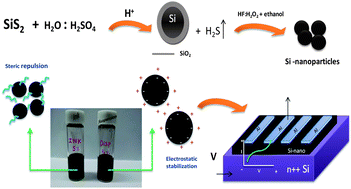Printable electronics-compatible silicon nanoparticles prepared by the facile decomposition of SiS2 and their application in a back-to-back Schottky diode†
Abstract
Crystalline

* Corresponding authors
a
Nanomaterials Science & Engineering, University of Science and Technology (UST), 176 Gajeong-ro, Yuseong-gu, Daejeon 305-350, Rep. of Korea
E-mail:
youngmin@krict.re.kr, bhryu@krict.re.kr
Tel: +82-42-860-7361
b Device Material Research Center, Korea Research Institute of Chemical Technology, P. O. Box 107, 141, Gajeong-ro, Yuseong-gu, Daejeon 305-600, Rep. of Korea
Crystalline

 Please wait while we load your content...
Something went wrong. Try again?
Please wait while we load your content...
Something went wrong. Try again?
P. V. More, S. Jeong, J. Lee, Y. Seo, B. Ryu and Y. Choi, J. Mater. Chem., 2012, 22, 23553 DOI: 10.1039/C2JM35349K
To request permission to reproduce material from this article, please go to the Copyright Clearance Center request page.
If you are an author contributing to an RSC publication, you do not need to request permission provided correct acknowledgement is given.
If you are the author of this article, you do not need to request permission to reproduce figures and diagrams provided correct acknowledgement is given. If you want to reproduce the whole article in a third-party publication (excluding your thesis/dissertation for which permission is not required) please go to the Copyright Clearance Center request page.
Read more about how to correctly acknowledge RSC content.
 Fetching data from CrossRef.
Fetching data from CrossRef.
This may take some time to load.
Loading related content
